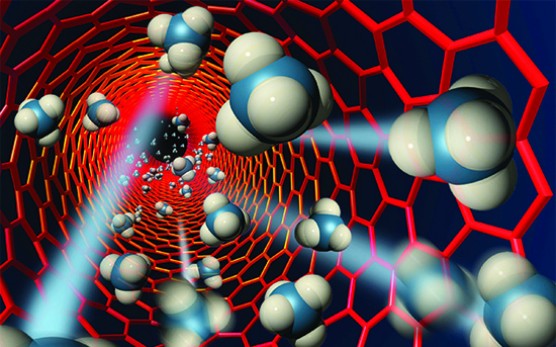Imagining the Invisible

On a recent visit to Pioneer Works in the Brooklyn Red Hook neighborhood, I heard a lecture by Matthew Putman on “Imaging the Invisible”. The venue is a newly renovated factory and warehouse dating back to 1866, when it was known as Pioneer Iron Works. Today, Pioneer Works is an incubation space for contemporary culture through exhibitions, studio residencies, an arts and culture magazine, and a lecture and workshop series. At the center of all this activity is Matthew Putman, Ph.D., the founder of Nanotronics, a microscopy company.
Putman began his lecture in the post-and-beam grand hall at Pioneer Works by referencing Richard Feynman’s 1959 lecture at the American Physical Society. “There is plenty of room at the bottom,” Feynman pointed out as he predicted many of the nanoscale technologies that have become common today.
These size-scales are poorly understood by most people. The best optical microscopes have a resolution of about 3 microns (0.000,003 meters or 3×10-6). Bacteria are generally 0.5 to 5 microns in size (the eukaryotic cells of plants and animals are on average about ten times the size of bacteria). A nanometer is orders of magnitude smaller than a micron, the difference between 1 millionth of a meter — a micron— and 1 billionth of a meter — a nanometer (0.000,000,001 or 10-9). The radius of individual atoms are measured on a scale of picometers or 1 trillionth of a meter (0.000,000,000,001 or 10-12).
Matthew Putman’s Nanotronics adds software to optical microscope allowing the computer to interpolate nanoscale resolutions from micronscale images.
One of the best analogies for understanding these scales is from Bill Bryson’s A Short History of Nearly Everything. Bryson writes:
“Blown up to a scale at which atoms were about the size of peas, a cell would be a sphere roughly half a mile across, and supported by a complex framework of girders called the cytoskeleton. Within it, millions upon millions of objects – some the size of basketballs, others the size of cars – would whiz about like bullets. There wouldn’t be a place you could stand without being pummeled and ripped thousands of times every second from every direction. Even for its full-time occupants the inside of a cell is a hazardous place. Each strand of DNA is on average attacked or damaged once every 8.4 seconds – ten thousand times in a day – by chemicals and other agents that whack into or carelessly slice through it, and each of these wounds must be swiftly stitched up if the cell is not to perish.
“The proteins are especially lively, spinning, pulsating and flying into each other up to a billion times a second. Enzymes, themselves a type of protein, dash everywhere, performing up to a thousand tasks a second. Like greatly speeded-up worker ants, they busily build and rebuild molecules, hauling a piece off this one, adding a piece to that one. Some monitor passing proteins and mark with a chemical those that are irreparably damaged or flawed. Once so selected, the doomed proteins proceed to a structure called a proteasome, where they are stripped down and their components used to build new proteins. Some types of protein exist for less than half an hour; others survive for weeks. But all lead existences that are inconceivably frenzied.” (477-478)
Of course, living cells have been doing nanotechnology for at least 3.5 billion years, but now humans are getting into the act too with new tools to image and manipulate nanoscale objects. The semiconductors in your computer and cellphone are the most ubiquitous examples thereof. Many new nanotechnologies are being developed for medicine and material sciences.
Putman shared a six-minute Big Think video by physicist Misho Kaku entitled “Can Nanotechnology Create Utopia?” Kaku asked what happens when we have mastered molecular-level engineer and are able to create a replicator as imagined in Star Trek? Kaku predicts a future without scarcity, a society of radical abundance, based on the technology of molecular-level replications.
Complimenting the theme of Putman’s talk was a large exhibition at Pioneer Works of the work of Ernesto Caivano’s fantastical, pen-ink drawings. The artwork was suggestive of complex, microscopic structures
In closing, we can mash up Feynman and Kaku: There is a lot of room at the bottom and that itself is a subversive idea. On the one hand, there are now promising technologies and research that will change the way we live. On the other hand, there is the growing awareness that the universe is as many magnitudes smaller than us as it is larger. We need to imagine invisibles that are both very large and very small. These invisible scales of space-time and matter-energy are the new reality.






